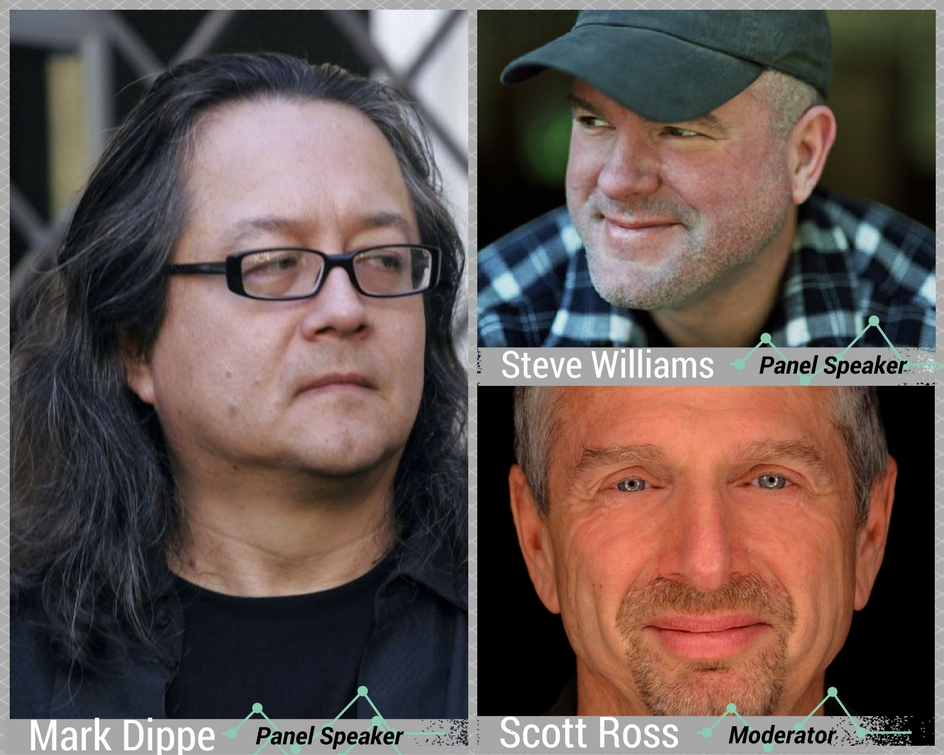-
 Full Conference
Full Conference
-
 Full Conference 1-Day
Full Conference 1-Day
-
 Basic Conference
Basic Conference
-
 Exhibitor
Exhibitor
Date/Time: 7 December 2016, 04:15pm - 06:00pm
Venue: Ballroom H, Level 3
Location: The Venetian Macao

Title: He's Back! T2 25 years later.
Panellists:
Mark Dippe, Assistant Visual Effects Supervisor for T2
Steve “Spaz” Williams, Computer Animation Supervisor for T2
Moderator:
Scott Ross, GM ILM, Co-Founder of Digital Domain with James Cameron
Summary: In 1991, 25 years ago, movie history was made with Terminator 2: Judgment Day (T2). The use of computer generated images in cinema had finally come of age. James Cameron and ILM utilized state of the art technology to help create some of the most memorable and iconic scenes and characters in the film. For those that have seen the movie, it’s hard to forget the liquid metal T1000. While T2 was never theatrically released in China, the movie has now, been remastered for a stereoscopic viewing experience specifically for the China market. Scott Ross, the former General Manager of ILM, will host an in depth discussion with Mark Dippe and Steve "Spaz" Williams, the team that created the breakthrough images. Attendees will be given a behind the scenes look at the challenges they faced, the technology they used, the process that was developed and the moment when they realized they had forever changed the landscape of feature films.
Presentation Language: English
Bio:
Mark Dippe, Assistant Visual Effects Supervisor for T2
Mark Dippé was born in Japan to parents, both of whom worked for the United States Army. At the age of two, the Dippés moved to Anchorage, Alaska. At the age of 5, Mark persuaded his mother to take him to see the 1958 horror film The Fly. The film's transformation sequences left such a strong impressed him, that he eventually grew an interest in visual effects. Mark left home at 17 and attended University of California, Berkeley, earning a Ph.D in computer graphics. Shortly after graduating, he went to Industrial Light & Magic as some friends of his were hired to do the computer-generated imagery for The Abyss. Mark wrote most of the code that created a photorealistic pseudopod built out of seawater, which was mostly animated by Steve “Spaz” Williams. Mark later work included the T-1000 in Terminator 2: Judgment Day, and the dinosaurs of Jurassic Park, which were rendered in computer graphics after a successful demo made by Steve and Mark. Mark, Steve and Clint Goldman left ILM in 1997, forming production companies Pull Down Your Pants and Complete Pandemonium. The former was a production company in Mark’s directorial debut, the comic book adaptation Spawn, and the latter created various television commercials in the following years. He is co-founder of The Animation Picture Company.
Steve “Spaz” Williams, Computer Animation Supervisor for T2
Steve “Spaz” Williams (born 1962) is a Canadian special effects artist and animator. Williams studied animation at Sheridan College, graduating in 1984. During the summers he would work at the Ontario Institute for Studies in Education Computer Laboratory, learning more about computer animation. After graduation, he went on to work at Alias Research (currently a part of Autodesk) in Toronto. He acted as the company's spokesperson, leading to a job at Industrial Light & Magic in 1988. ILM had purchased Silicon Graphics computers to create the computer-generated effects in The Abyss, and said workstations used Alias modeling software. Along with animators Mark Dippé, Scott Anderson and Jay Riddle, Williams helped develop a photorealistic alien pseudopod made out of seawater, which later earned the film an Academy Award for Best Visual Effects. Continuing at ILM, Williams worked in two more breakthrough moments of CG effects that earned the company more Oscars: the T-1000 from Terminator 2: Judgment Day (1991), a liquid metal robot that evolved from the work done in The Abyss; and the Tyrannosaurus in Jurassic Park (1993). As the chief computer graphics animator of The Mask, Williams shared a nomination for Best Visual Effects (along with Tom Bertino, Jon Farhat and Scott Squires) at the 67th Academy Awards. Williams left ILM along with Dippé following their work in Spawn (1997), which Dippé directed with Williams being the effects supervisor and second unit director. Along with a job at New Line Productions, Williams opened Hoytyboy Productions in San Francisco. Hoytyboy's biggest work was 2006's The Wild for Walt Disney Pictures, which Williams directed. He also directed more than 200 commercials for 1997 and 2010, for clients including Capital One, Toyota, AT&T, Lexus and McDonald's.
Scott Ross, GM ILM, Co-Founder of Digital Domain with James Cameron
As one of the most notable pioneers in digital media, technology and entertainment, Scott Ross’ career has been stellar. He founded, along with James Cameron, Digital Domain, one of the largest digital production studios in the motion picture and advertising industries. Under Ross’ direction, Digital Domain garnered multiple Academy Award nominations, receiving its first Oscar for the ground breaking visual effects in TITANIC. A second Oscar for WHAT DREAMS MAY COME and a third for THE CURIOUS CASE OF BENJAMIN BUTTON followed that success. Digital Domain received additional nominations for TRUE LIES, APOLLO 13 and I, ROBOT and has won four Scientific and Technical Achievement Academy Awards for its proprietary software. Under his watch, Digital Domain also developed the most robust compositing software, NUKE, which to this day is still the industry standard. As well as the mentioned Oscar nominated films, Ross oversaw the company that created imagery for movies such as THE FIFTH ELEMENT, FIGHT CLUB, TRUE LIES, INTERVIEW WITH THE VAMPIRE, O BROTHER WHERE ART THOU, X-MEN, THE LORD OF THE RINGS, THE DAY AFTER TOMORROW and many, many others.
Ross has worked with the who’s who of film directors such as Cameron, Bay, Fincher, Howard, Scorsese, Coppola, The Coen Brothers, Spielberg, Kurosawa, Jackson, and Salles and generally, has nice things to say about them. In 2006 as Digital Domain’s CEO and Chairman, he successfully sold Digital Domain to director Michael Bay and a group of private equity investors.Prior to forming Digital Domain, he led George Lucas’ vast entertainment empire, running ILM, Skywalker Sound, LucasFilm Commercial Productions and DroidWorks. Ross first joined LucasFilm as General Manager of Industrial Light and Magic and under his leadership; ILM won five Academy Awards for Best Visual Effects (WHO FRAMED ROGER RABBIT; INNERSPACE; TERMINATOR 2; THE ABYSS; DEATH BECOMES HER). The company re-organized in the 90’s and Ross was named Sr. VP of the LucasArts Entertainment Group, which was comprised of Skywalker Sound, LucasArts Commercial Productions, LucasArts Attractions, Editdroid/Soundroid and ILM.
Ross has played a significant role in the worldwide advertising industry as well. Having started commercial production companies whilst at LucasFilm (ILM and LCP) as well as Digital Domain’s Commercials Division, he had led two of the largest VFX commercial production companies on the planet. In addition to the visual effects divisions, Mr. Ross launched Digital Domain Films, a feature film production division. A native of New York City, Ross began his career in Media Studies at Hofstra University where he graduated with a BS in Communication Arts. He returned to Hofstra to receive an honorary doctorate degree from his alma mater. Ross is a member of the Academy of Motion Picture Arts and Sciences (OSCARS) and The Academy of Television Arts and Sciences (EMMYS). He has worked on over 100 of the world’s largest special effects films and has lectured extensively about the creative process, content and technology in over 30 countries around the world. He was a visiting professor at Savannah College of Art and Design (SCAD), a professor at Daichi University in Fukuoka and Kyoto Computer Gakuin. Scott now sits on the Advisory Board of Magic Leap, the $4.5 billion augmented reality company. He is also an advisor to Lenovo Computers, DMM Futureworks, China’s DeTao Academy and Eyellusions/NY (a hologram production company).


